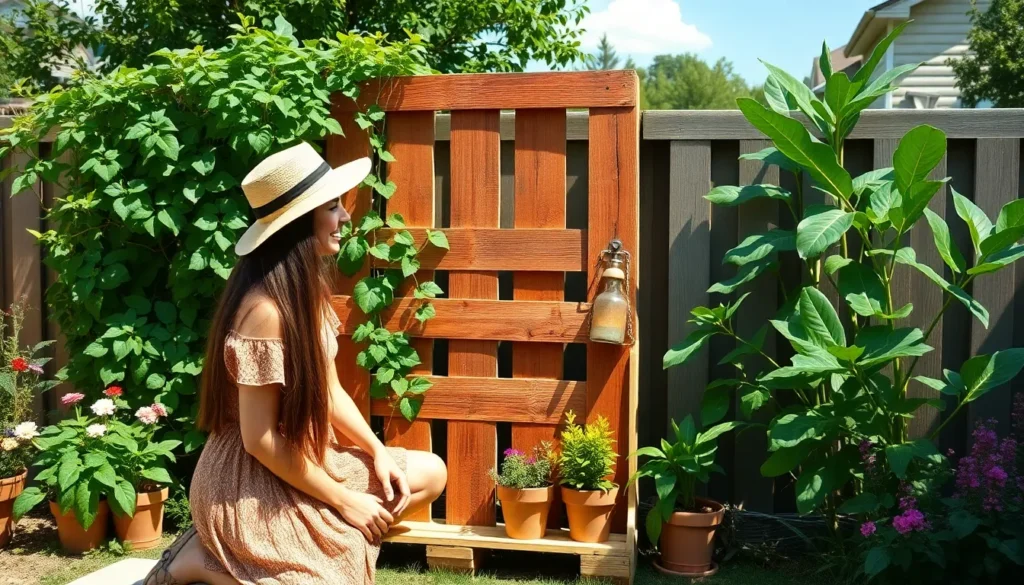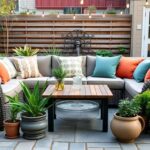We all crave that perfect outdoor sanctuary where we can relax without prying eyes or unwanted interruptions. Whether it’s your backyard deck, patio, or garden space, creating privacy shouldn’t drain your wallet or require a complete industry overhaul.
Privacy answers don’t have to be expensive to be effective. From clever DIY screens and strategic plant placement to repurposed materials and creative barriers, there are countless budget-friendly ways to transform your outdoor space into a private retreat. We’ve discovered that the most stunning privacy answers often come from thinking outside the box and using everyday items in unexpected ways.
The best part? Most of these privacy ideas can be implemented in a weekend without special tools or professional help. You’ll be amazed at how a few strategic changes can completely transform your outdoor experience while keeping your budget intact.
Natural Privacy Screens Using Living Plants
Living plants offer the most cost-effective way to create natural barriers while adding beauty to your outdoor space. These green answers grow stronger and more effective over time without requiring ongoing replacement costs.
Fast-Growing Hedge Options
Privet hedges establish dense privacy screens within 2-3 growing seasons when planted 18-24 inches apart. We recommend this hardy shrub because it tolerates various soil conditions and grows 12-24 inches annually. Trimming twice yearly maintains the desired height and thickness.
Leyland cypress creates tall privacy walls reaching 15-20 feet in just 5-7 years with proper spacing of 6-8 feet between plants. This evergreen option provides year-round coverage and withstands harsh weather conditions. Initial investment stays low when purchasing smaller nursery plants rather than mature specimens.
Forsythia bushes deliver spring blooms alongside privacy coverage growing 6-10 feet tall within 3-4 years. Plant these flowering shrubs 4-5 feet apart for optimal screening density. Annual pruning after blooming encourages bushier growth patterns.
Bamboo Privacy Answers
Clumping bamboo varieties like Fargesia species grow 8-12 feet tall without spreading aggressively throughout your yard. We suggest planting these non-invasive types 3-4 feet apart for complete privacy coverage within 2 years. Container planting controls growth while reducing installation costs.
Golden bamboo reaches impressive heights of 20-25 feet but requires root barriers to prevent unwanted spreading. This running variety costs less initially but needs ongoing maintenance to contain growth. Installing 24-inch deep barriers around planting areas prevents costly removal later.
Bamboo screening panels made from harvested culms provide instant privacy at fraction of fence costs. We construct these DIY panels using bamboo poles secured with wire or zip ties to existing posts. Replacement panels cost under $30 each compared to hundreds for traditional fencing.
Climbing Vines for Vertical Coverage
English ivy covers unsightly walls and fences within one growing season when planted 12 inches apart along support structures. This evergreen climber thrives in shade or sun while requiring minimal water once established. Regular trimming prevents damage to underlying surfaces.
Clematis vines produce stunning flowers while creating living privacy curtains on trellises or wire supports. We plant different varieties for continuous blooms from spring through fall. Initial vine costs range from $15-25 each with coverage expanding rapidly in subsequent seasons.
Virginia creeper transforms chain link fences into green privacy walls growing 30-50 feet in all directions. This native vine adapts to poor soil conditions and provides brilliant fall color before winter dormancy. Five-leaflet identification helps distinguish it from poison ivy during planting.
DIY Fence Alternatives on a Budget
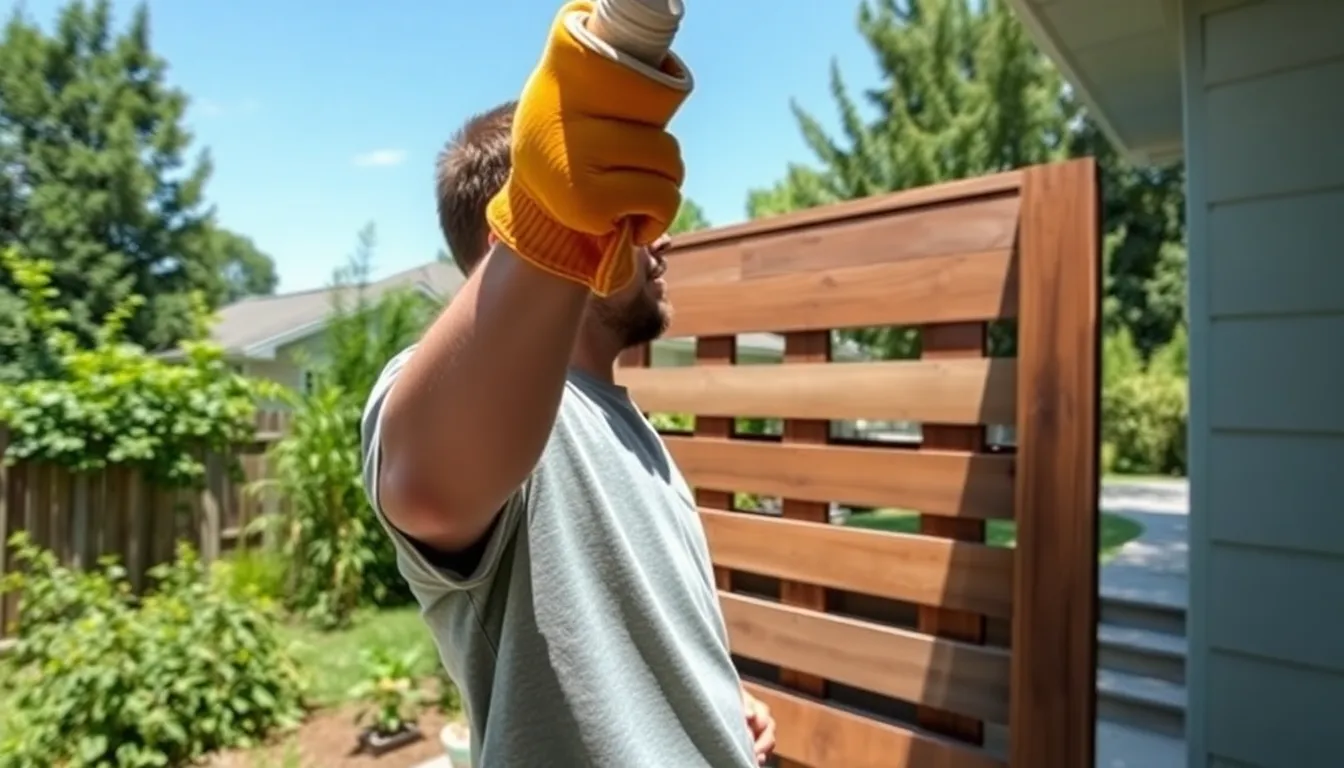
Building your own privacy fence doesn’t have to drain your savings account. We’ll explore three cost-effective materials that deliver impressive results while keeping your budget intact.
Pallet Wood Privacy Walls
Repurposing wooden pallets creates the most budget-friendly privacy solution available today. We can often source pallets completely free from nurseries, construction sites, and warehouses that are eager to dispose of them. These sturdy platforms transform into rustic privacy walls when installed vertically or horizontally between fence posts.
Choosing the right pallets requires attention to detail. Look for the IPPC logo stamped on the wood, which indicates proper heat treatment and prevents pest infestations in your yard. Exercise caution when handling pallets since they contain exposed nails and can produce painful splinters without proper gloves.
Installation costs remain minimal because we’re primarily purchasing fasteners and mounting hardware rather than expensive lumber. This approach saves hundreds of dollars compared to traditional cedar or pine fencing while delivering the same privacy benefits.
Lattice Panel Installations
Installing lattice panels provides semi-private screening that balances privacy with airflow and natural light. We love this option because it creates an open, airy feeling while still defining boundaries and blocking unwanted views. The decorative diamond or square patterns add visual interest that solid fencing simply can’t match.
Combining lattice with climbing plants amplifies its privacy potential naturally. Morning glories, sweet peas, and climbing beans weave through the openings to create living walls that change with the seasons. This partnership between structure and nature costs significantly less than solid wood alternatives.
Mounting these panels onto existing fence posts or structures makes installation straightforward for weekend DIY projects. We can attach them directly to property line fences or use them to extend the height of shorter barriers without major construction work.
Corrugated Metal Screening
Corrugated metal panels deliver modern privacy screening that withstands weather extremes better than wood alternatives. We appreciate this material’s durability since it resists rot, insects, and warping that plague traditional fencing materials. The sleek industrial appearance complements contemporary home designs perfectly.
Installing metal panels vertically creates clean lines and maximum privacy coverage. Alternatively, horizontal installation produces a more relaxed, ranch-style aesthetic that works well with existing wooden fence frameworks. The lightweight nature of corrugated metal makes handling and positioning manageable for most homeowners.
Combining metal panels with wooden posts keeps material costs reasonable while simplifying the installation process. We can create striking contrasts between warm wood tones and cool metal finishes that enhance rather than detract from industry designs.
Repurposed Materials for Outdoor Privacy
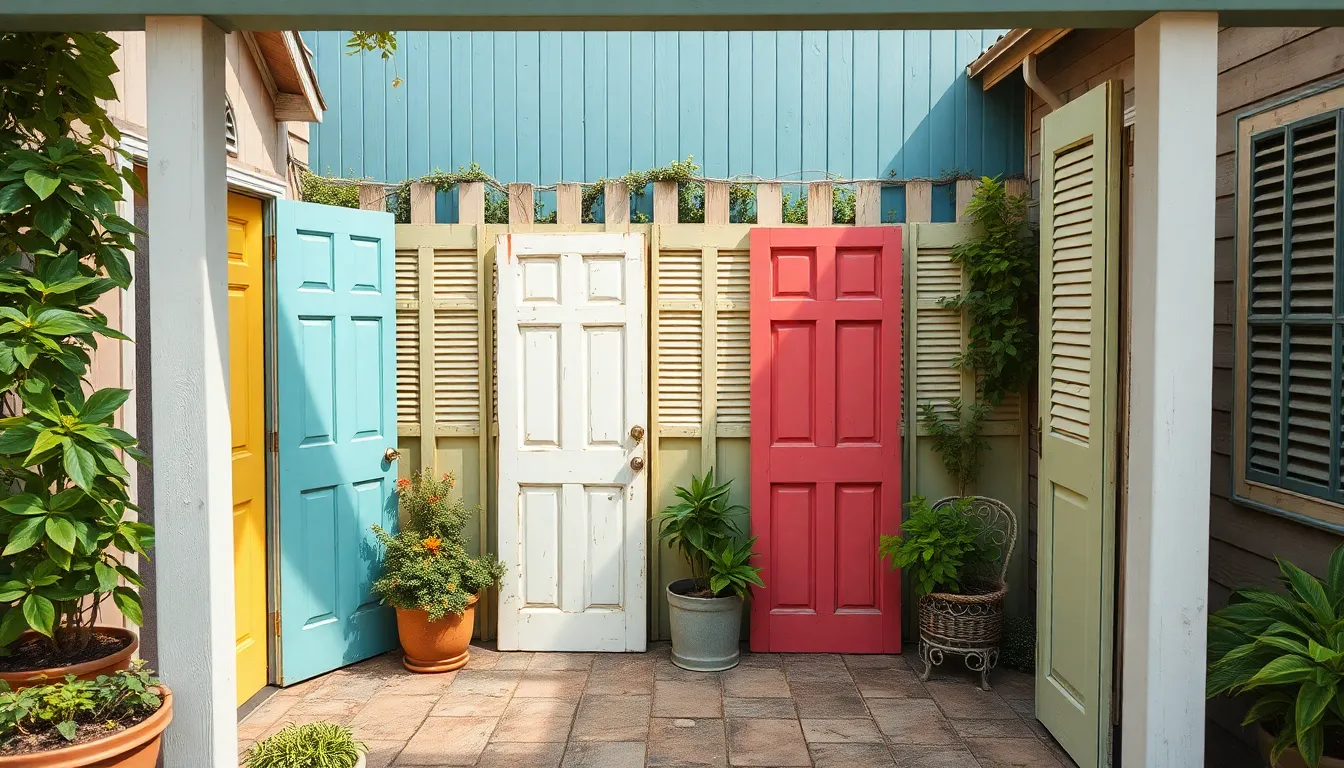
Transforming discarded items into functional privacy screens creates unique outdoor spaces while keeping costs minimal. We’ll explore creative ways to give new life to materials that might otherwise end up in landfills.
Old Doors and Windows as Screens
Interior doors make excellent privacy screens when repainted and positioned strategically around patios or deck areas. Salvage yards and online marketplaces offer these materials at incredibly low prices, sometimes free during home renovation clean-outs. Repainting transforms worn doors into stylish barriers that define spaces without creating complete enclosures.
Windows work beautifully as vertical panels, especially when their frames receive fresh paint or stain treatments. Their transparent sections allow light flow while creating visual barriers, and multiple windows can be hinged together for flexible positioning. Window shutters add architectural interest when arranged side by side, creating charming cottage-style privacy screens that complement various outdoor décors.
Propping these materials requires minimal hardware investment, making this approach both budget-friendly and DIY-accessible. We recommend securing them properly to prevent tipping while maintaining their moveable nature for seasonal adjustments.
Fabric and Canvas Panels
Canvas drop cloths stretch easily over frames to create soft, breathable privacy barriers that cost significantly less than traditional screening materials. Outdoor curtains or repurposed sailcloth can be hung from existing structures using basic hardware, offering customizable color and pattern options that complement your space.
Fabric panels provide flexibility that rigid materials can’t match, allowing air circulation while obscuring direct views. We’ve found that canvas materials withstand weather conditions better than indoor fabrics, making them practical for year-round outdoor use. Installation requires only basic mounting hardware, keeping project costs under $50 for most applications.
Replacement becomes simple when fabrics wear out, allowing seasonal updates without major reinvestment. Fabric panels also fold easily for storage during harsh weather periods, extending their usable life significantly.
Salvaged Shutters and Room Dividers
Wooden shutters create rustic privacy screens when mounted outdoors, offering adjustable coverage through their louvered design. Folding configurations allow customized privacy levels while maintaining the cottage aesthetic that many homeowners desire. Salvaged shutters often cost under $20 each at architectural salvage stores, making complete privacy walls achievable for under $200.
Indoor room dividers adapt well to outdoor environments when treated with weather-resistant finishes. Folding screens made from wood or durable materials provide moveable privacy answers that can be repositioned as entertaining needs change. We’ve successfully used vintage accordion-style dividers to create intimate dining areas within larger outdoor spaces.
Wood pallets assembled in desired patterns create rustic privacy walls with minimal expense, as these materials are frequently available free from businesses. Their partial assembly reduces labor time while their industrial aesthetic complements modern outdoor designs. Modular plastic panels offer lightweight alternatives that withstand weather extremes while providing clean, contemporary screening options.
Temporary Privacy Solutions for Renters
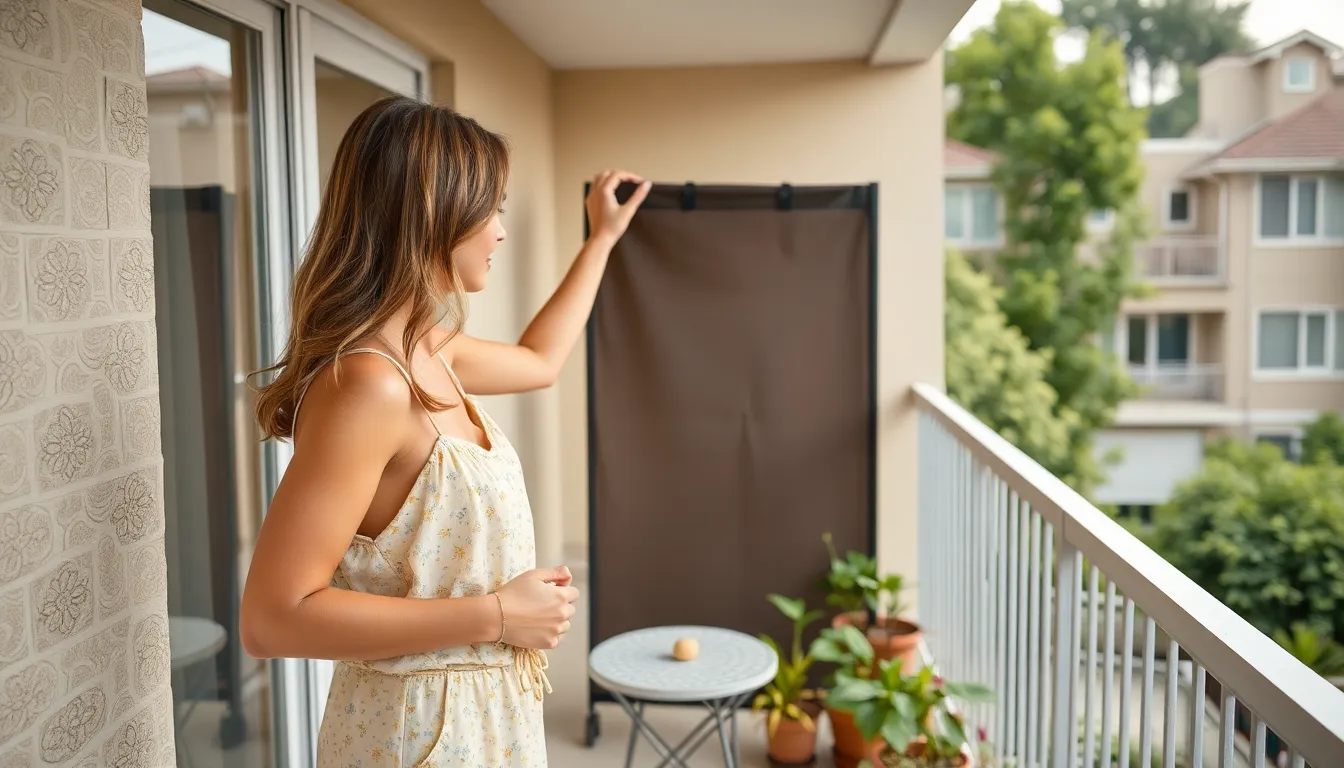
Renters can create outdoor privacy without permanent alterations using temporary answers that won’t damage property or violate lease agreements.
Portable Privacy Screens
Portable privacy screens offer freestanding panels that we can position and relocate as needed throughout our outdoor spaces. These lightweight screens work perfectly for balconies, patios, or shared outdoor areas where flexibility is essential. Foldable designs allow easy storage and transport when not in use.
Building DIY versions keeps costs low while providing custom privacy answers. We can construct screens using lattice panels, repurposed materials, or wooden frames covered with fabric. Many renters choose lightweight materials that won’t create wind resistance or require heavy anchoring systems.
Outdoor Curtains and Drapes
Hanging outdoor curtains creates soft privacy barriers without permanent installation methods. Tension rods eliminate the need for screws or nails while providing secure mounting for curtains. Removable ceiling tracks or hook systems protect rental properties from damage.
Weather resistant fabrics ensure durability against rain, sun, and wind exposure. We can create cozy, shaded retreats that add aesthetic appeal alongside privacy benefits. Curtains divide outdoor spaces temporarily just like indoor room dividers, offering flexible privacy control throughout different times of day.
Moveable Planter Boxes
Moveable planter boxes create natural privacy screens using tall plants that shield outdoor areas from view. Bamboo, ornamental grasses, and small shrubs provide excellent coverage when planted in portable containers. These green answers enhance outdoor ambiance while improving air quality around our living spaces.
Flexibility remains a key advantage since we can rearrange planters or bring them indoors when seasons change. DIY planters built from inexpensive materials suit any budget while providing custom sizing for exact privacy needs. Plants grow over time, creating increasingly dense privacy barriers that improve with age.
Creative Vertical Garden Privacy Ideas
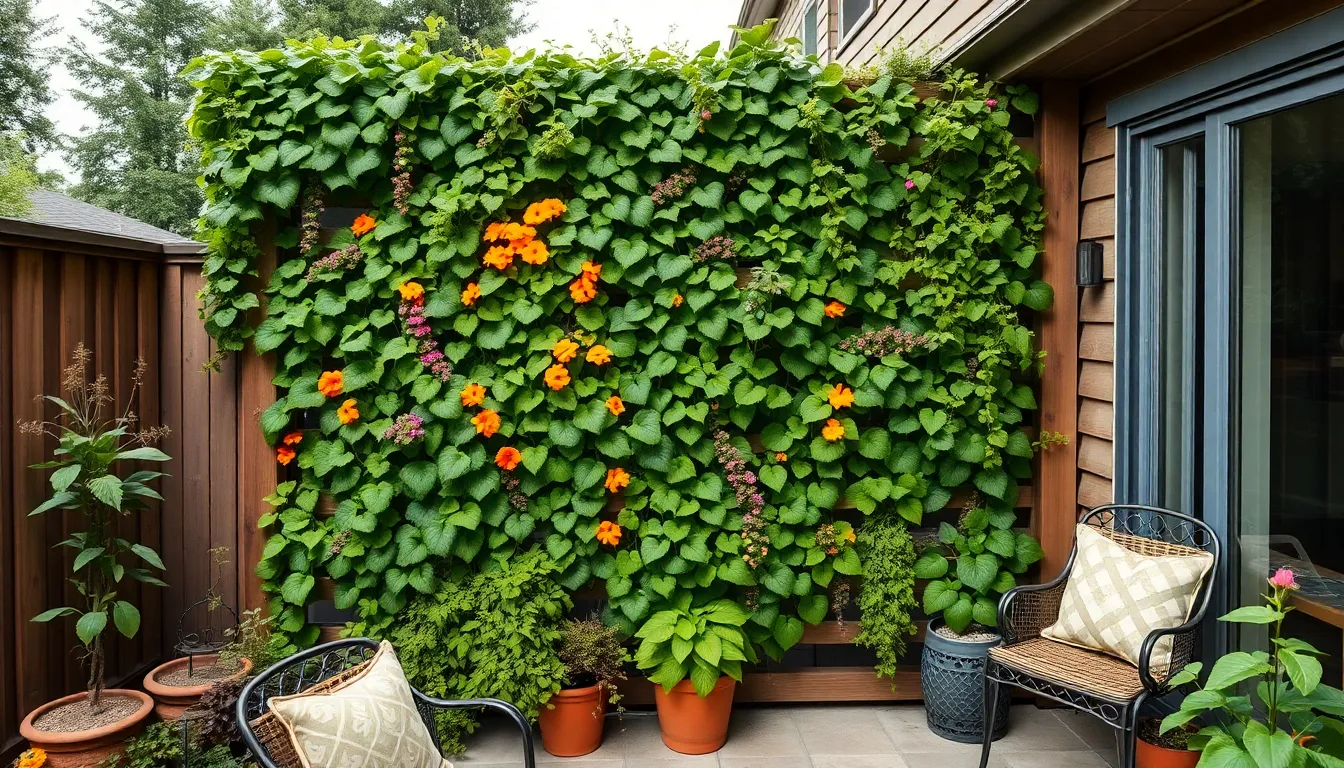
Vertical gardens maximize your outdoor space by growing upward instead of outward, creating stunning privacy screens from repurposed materials. We’ll show you how to transform everyday items into lush, living barriers that protect your privacy while adding natural beauty.
Living Wall Installations
Living walls create dense vertical plantings that cover entire walls or panels with vibrant greenery. Succulents work exceptionally well for these installations because of their low water requirements and diverse shapes and colors. Examples include Sedum varieties, Echeveria rosettes, and compact Aloe plants that thrive in vertical arrangements.
DIY living walls use shallow fabric pockets or grid-like trays filled with soil to support small plants in striking displays. We recommend starting with drought-tolerant plants that establish quickly and require minimal maintenance. Fabric pocket systems attach easily to existing fences or walls, creating an instant green privacy screen.
Faux living walls offer another option for renters or those seeking zero-maintenance answers. Artificial greenery panels attached to trellises mimic the natural look without requiring water, pruning, or seasonal care. These synthetic alternatives provide consistent coverage year-round while delivering the same visual privacy benefits.
Trellis Systems with Climbing Plants
Trellises provide essential framework for climbing plants to grow vertically and block unwanted views naturally. Simple wooden or metal structures can be built inexpensively or purchased ready-made for strategic placement along fence lines or patio edges. Position these supports where you need the most privacy coverage for maximum effectiveness.
Climbing plants like nasturtiums, peas, squash, and strawberries grow well on trellis systems with minimal care required. Nasturtiums attract beneficial pollinators while deterring harmful pests from your garden space. Edible climbers such as peas and strawberries provide fresh produce alongside privacy screening.
Fast-growing annual vines fill in trellises quickly during a single growing season. Perennial climbers establish stronger root systems that return each year with denser coverage. We suggest combining both types for immediate privacy that improves over time.
Hanging Garden Privacy Screens
Hanging baskets suspended at various heights create layered privacy screens that maximize vertical space efficiently. This flexible approach works perfectly for small patios or balconies where ground space is limited. Containers can be easily rearranged or moved as your privacy needs change throughout the seasons.
Compact vegetables, trailing herbs, and colorful flowers thrive in hanging garden systems. Oregano and thyme cascade beautifully from elevated planters while providing fresh herbs for cooking. Nasturtiums and petunias add bright colors and attract pollinators to your outdoor space.
Staggered hanging heights create visual depth while blocking sight lines from multiple angles. We recommend using lightweight containers to reduce stress on hanging hardware and make repositioning easier. Trailing plants naturally fill gaps between containers for complete privacy coverage.
Budget-Friendly Hardscape Privacy Options
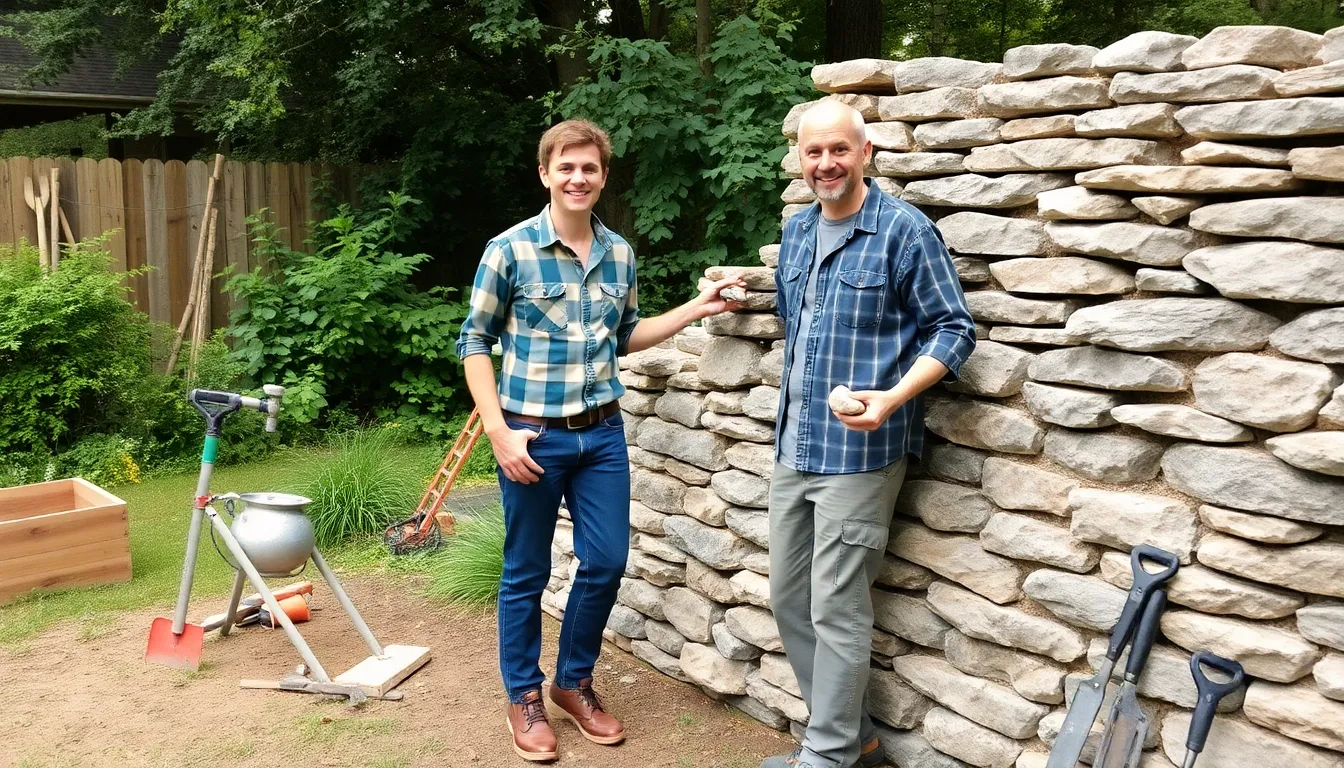
Hardscape privacy answers offer permanent structures that require minimal maintenance once installed. We’ve found these durable options provide excellent value while creating attractive outdoor barriers.
Stacked Stone Walls
Stacked stone walls create stunning natural privacy barriers without requiring expensive mortar or professional installation. We can build these dry-stacked structures using local stone or reclaimed materials, significantly reducing material costs compared to traditional masonry walls.
Building these walls requires only basic stacking skills and careful attention to balance and stability. Local quarries often sell irregular stones at discounted rates, making this option accessible for most budgets. We recommend starting with a solid foundation and gradually building height while ensuring each stone locks securely with those below.
These versatile structures serve multiple purposes beyond privacy, functioning as garden borders, retaining walls, or casual seating areas. The modular nature allows us to customize height and length based on exact space requirements and budget constraints. Most homeowners can complete a basic stacked stone wall project over a weekend using standard hand tools.
Concrete Block Answers
Concrete blocks offer the most cost-effective hardscape privacy solution for larger areas. Standard cinder blocks cost significantly less than natural stone while providing excellent durability and weather resistance over decades of use.
Installing concrete block walls requires basic masonry skills and simple tools like a level, rubber mallet, and measuring tape. We can leave blocks unfinished for a modern industrial aesthetic or enhance them with stucco, paint, or decorative facades to match existing industry design.
Adding climbing plants or installing trellis systems directly onto block walls creates an attractive living privacy screen. This approach combines the structural benefits of concrete with the natural beauty of vegetation, softening the industrial appearance while maintaining long-term durability.
The versatility of concrete blocks allows for creative design answers including planters, benches, or decorative patterns. We can stack blocks in various configurations to create visual interest while maintaining privacy functionality throughout the outdoor space.
Gabion Wall Alternatives
Gabion walls consist of wire mesh cages filled with stones, rocks, or recycled materials, creating rustic privacy barriers at minimal cost. These structures require no special tools or advanced construction skills, making them ideal for DIY installation projects.
Filling gabion cages with local rocks or recycled concrete significantly reduces material costs compared to purchasing premium stone. We can source materials from construction sites, demolished buildings, or natural areas with proper permission, creating an environmentally friendly privacy solution.
These wire cage structures provide excellent noise reduction and erosion control benefits beyond basic privacy screening. The natural drainage properties prevent water buildup while maintaining structural integrity through freeze-thaw cycles and severe weather conditions.
Combining gabions with strategic landscaping creates attractive natural privacy screens that blend hardscape elements with living plants. We can plant climbing vines directly into the rock gaps or position containers along the base for additional greenery without compromising structural integrity.
Multi-Purpose Privacy Structures
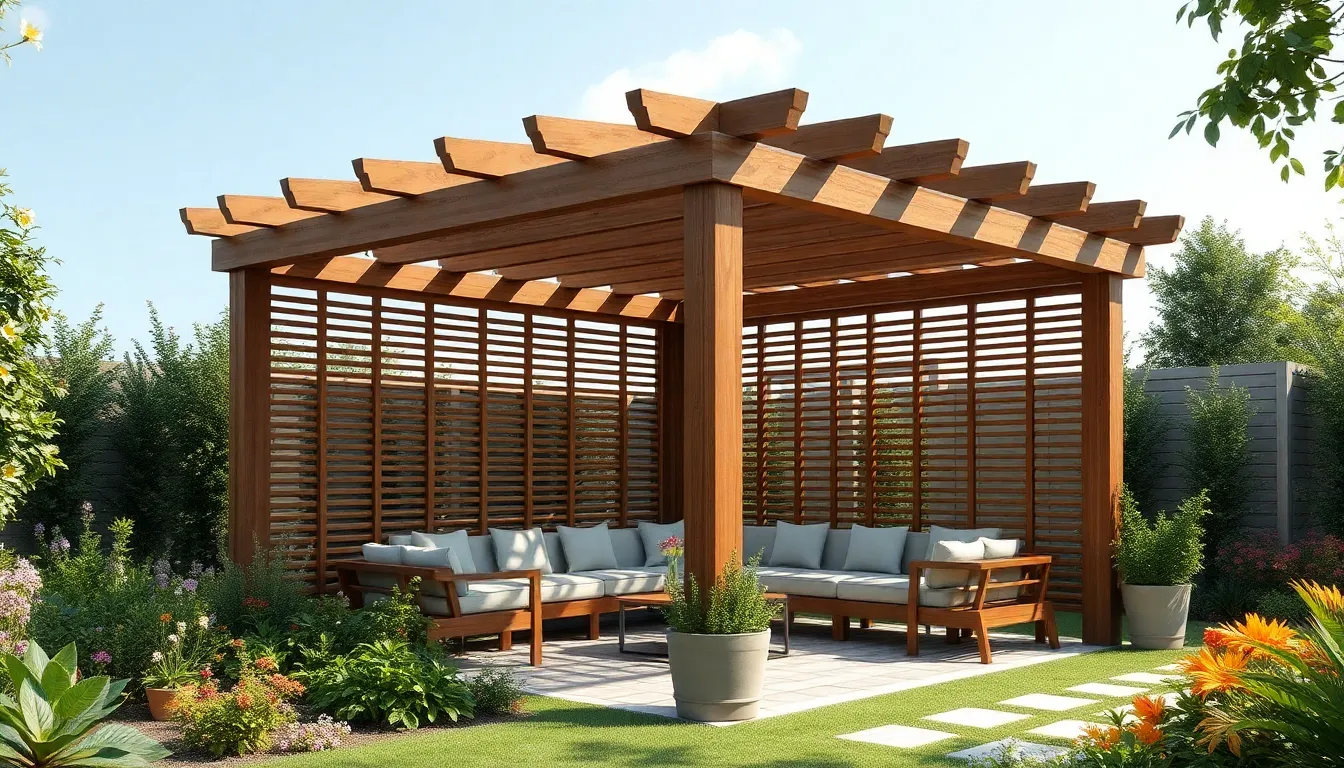
We’ve discovered that the most cost-effective outdoor privacy answers accomplish multiple tasks at once. Multi-purpose structures maximize your investment by combining shade, privacy, and functional features like seating or storage.
Privacy Screens with Storage
Privacy screens transform into organizational powerhouses when we integrate storage features directly into their design. Built-in shelves, cabinets, and compartments allow these barriers to hold gardening tools, outdoor cushions, and entertaining accessories without requiring separate storage units.
Materials for these dual-purpose screens range from traditional wood and composite lumber to rust-free powder-coated aluminum that withstands weather while maintaining appearance. Movable options provide flexibility for rearranging your space, while fixed installations offer superior stability and long-term durability.
We recommend designing screens with weatherproof storage compartments at varying heights to accommodate different items. Tool holders, planter boxes, or even small outdoor refrigerators can be incorporated into the screen structure, creating an organized and private outdoor environment.
Seating Walls with Height Extensions
Seating walls become effective privacy barriers when we extend their height using affordable materials and creative design. These functional industry features serve as comfortable outdoor furniture while providing visual separation from neighbors.
Building materials like concrete blocks, bricks, or treated wood keep costs manageable while creating sturdy foundations. Height extensions using lattice panels, wooden slats, or decorative screens add privacy without significantly increasing expenses.
Strategic placement of these walls around patios, fire pits, or garden areas creates intimate outdoor rooms. We suggest incorporating planter boxes on top of seating walls to combine privacy screening with beautiful landscaping elements that enhance the overall aesthetic.
Pergolas with Privacy Panels
Pergolas combined with privacy panels create stylish outdoor rooms that balance openness with intimate screening. These structures provide dappled shade while privacy panels on the sides or back offer protection from neighboring views.
Panel options include slatted wood, lattice work, fabric curtains, or composite screens that can be installed based on your exact privacy needs and budget. Ready-made panels reduce installation complexity, while DIY options using cedar or composite materials keep costs minimal.
We’ve found that positioning panels strategically on pergolas allows for customizable privacy levels throughout different seasons. Removable panels provide flexibility for entertaining larger groups, while permanent installations create consistent intimate spaces for relaxation and dining.
Conclusion
Creating your dream outdoor oasis doesn’t require very costly or hiring contractors. We’ve shown you that privacy and beauty can go hand in hand with creativity and resourcefulness.
From living walls to repurposed materials these answers prove that effective outdoor privacy is within everyone’s reach. Whether you’re a homeowner looking for permanent changes or a renter needing temporary fixes there’s an option that fits your situation and budget.
The key is starting small and building your privacy sanctuary one project at a time. With these ideas you’ll transform your outdoor space into the private retreat you’ve always wanted while keeping costs low and satisfaction high.
Frequently Asked Questions
What are the most budget-friendly ways to create outdoor privacy?
The most cost-effective outdoor privacy solutions include DIY screens made from repurposed materials like wooden pallets, lattice panels, and old doors. Strategic plant placement using fast-growing hedges, climbing vines, and moveable planter boxes also provides excellent privacy without breaking the budget. These options typically cost a fraction of traditional fencing.
Which plants provide the fastest privacy screening?
Fast-growing hedge options like privet and Leyland cypress offer dense coverage quickly. Bamboo varieties provide excellent height, while climbing vines such as English ivy and clematis create vertical coverage. Forsythia bushes add seasonal blooms while screening. Most of these plants establish privacy within one to two growing seasons.
Can renters create privacy without permanent installations?
Yes, renters have several temporary privacy options including portable freestanding screens, outdoor curtains hung on tension rods, and moveable planter boxes with tall plants. These solutions don’t require permanent alterations and can be easily repositioned or removed when moving, making them perfect for rental properties.
How can I repurpose household items for outdoor privacy?
Common household items like old doors, windows, shutters, and room dividers can be transformed into stylish privacy screens. Simply clean, repaint if needed, and position strategically. Fabric panels, canvas, and even corrugated metal can create effective barriers when mounted on simple frames or existing structures.
What are living walls and how do I create them?
Living walls are vertical gardens that provide privacy while maximizing space. Create DIY versions using fabric pockets or trays filled with drought-tolerant plants like succulents. Install trellis systems for climbing plants, or use hanging baskets to create layered privacy screens that combine aesthetics with functionality.
Are there hardscape privacy options on a budget?
Yes, budget-friendly hardscape solutions include stacked stone walls, concrete block walls, and gabion walls made from wire mesh filled with stones. These materials are often available at lower costs and can be installed as DIY projects, providing durable privacy barriers that complement various outdoor design styles.
How can I create multi-purpose privacy structures?
Combine privacy with functionality by building structures that serve multiple purposes. Create seating walls that extend upward for privacy, install privacy screens with built-in storage compartments, or construct pergolas with removable privacy panels. These solutions maximize your investment by serving several outdoor living needs simultaneously.
What privacy solutions work best for small outdoor spaces?
Vertical solutions work best in small spaces. Use climbing plants on trellises, hanging garden screens, or tall moveable planters. Fabric panels and outdoor curtains take up minimal floor space while providing effective screening. These options create privacy without overwhelming compact patios or balconies.

